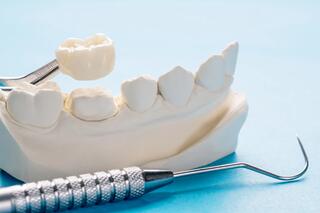Crowns are one of the most effective solutions for restoring the functionality and aesthetics of teeth. They play a key role in protection and restoration, and with modern technologies allowing for high aesthetics and durability. In this article, you will learn about different types of crowns, how to choose the right material, and the steps involved in their installation. Read to the end to understand all the nuances and make the right choice.
What is a Crown
A dental crown is a fixed structure that fits over a damaged tooth, restoring its shape, color, and function. It helps protect the tooth from further damage and extends its lifespan. A crown shields the tooth from mechanical impacts and bacteria and can be placed on both natural teeth and implants.
Types of Crowns
By Material
-
Acrylic Crowns. A temporary and affordable solution, typically used before permanent structures are placed. Pros: low cost, ease of fabrication. Cons: low strength and tendency to discolor over time.
-
Metal-Ceramic Crowns. A metal base for strength, covered with ceramic for aesthetics. Pros: durability, reliability. Cons: possible gum discoloration and higher pressure on tooth tissues.
-
Ceramic Crowns. Provide high aesthetics, closely resembling natural teeth. Pros: excellent aesthetics, hypoallergenic. Cons: relatively high cost.
-
Zirconia Crowns. Strong and aesthetically appealing, especially when coated with ceramic. They are resistant to wear and heavy loads. Additional pros include biocompatibility. Cons: high cost.
By Usage Time
-
Temporary Crowns. Used for a period ranging from a week to several months while a permanent structure is being prepared. They protect the tooth and maintain its function but are less durable. Also used to preserve the aesthetics of the dental row after tooth extraction and implant placement.
-
Permanent Crowns. Designed for long-term use, with a lifespan of 10 years or more with proper care (referring to metal-ceramic, ceramic, and zirconia crowns).
By Type
-
Full Crowns. Cover the entire tooth, protecting it from damage and restoring its aesthetic appearance. They are also placed on implant abutments.
-
Crowns on Post Cores. Used for severely damaged teeth. They are supported by a metal post, which strengthens the crown's structure and helps it last longer.
Stages of Installation
The process of crown installation involves several steps:
-
Diagnosis and Planning:
At this stage, the dentist evaluates the condition of the tooth, takes an X-ray, and develops a treatment plan. -
Tooth Preparation and Impressions:
The tooth is prepared for crown placement, and impressions are taken to create a crown that perfectly fits in shape and size. -
Placement of a Temporary Crown:
A temporary crown is placed to protect the prepared tooth. -
Trial and Installation of the Permanent Crown:
Once the permanent crown is ready, a fitting is done for adjustments if necessary, after which the crown is cemented in place (if it is placed on an implant, it is fixed on the abutment).
